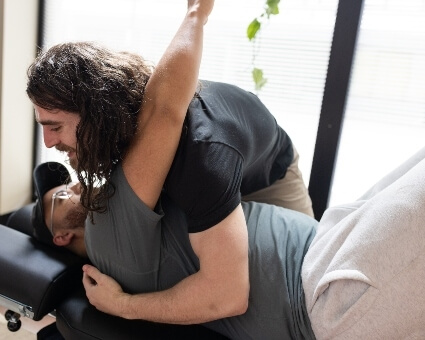Shoulder Pain Relief in Portland
The Move Better Approach
 Treating shoulder pain is one of the best examples of what Move Better does best; observe the problem, provide a logical alternative, practice a neurological solution beyond standard chiropractic care.
Treating shoulder pain is one of the best examples of what Move Better does best; observe the problem, provide a logical alternative, practice a neurological solution beyond standard chiropractic care.
Problem
If we were to ask most people to point to their shoulder, almost everyone would point to the joint where the arm meets the shoulder blade. Around this joint would be relatively very small muscles such as the deltoid and rotator cuff muscles. These are also almost always the areas that people have shoulder pain. This is also where most people apply force and load to start the motion of the arm. This simple idea is exactly where shoulder pain starts. The body is being told to use very small muscles when much larger muscles could do the same task.
Functionally, the arm attaches to the shoulder blade which attaches to the upper back. Attached to the shoulder blade (scapula) are large muscles that can perform a lot of work. Using the shoulder blade also allows two very large muscles that attach to the arm (humerus) to have much better leverage: the latissimus dorsi and pectoralis major.
When we watch a person who has shoulder pain try to move their arm, there is one resounding common issue. The shoulder blade does not move much (or at all) and almost all motion occurs in the arm. When the shoulder blade does move it almost always moves towards the neck. In our Movement Paradigm Evaluation, we simply ask a patient to raise their arms in front of them to an overhead position. The second most common evaluation is asking our patients to grab something and pull it towards them, usually a cable machine handle or band. This is usually all we need to know where to start with shoulder pain. In both movements, we see lots of other things move like the arm, neck, and upper back. What we usually don’t see move is the shoulder blade. If a clinician doesn’t pay attention to the details of what’s happening, these simple movements can be entirely overlooked for their clinical value. At Move Better we pay attention to everything. Taking that attention to these movements allows us to see a huge amount of information that many providers miss.
Alternative
That attention now starts the conversation of what would be a logical alternative. If we are observing that:
- The shoulder blade does not move much
- Small muscles around the shoulder joint are being asked to do most of the work
- The arm is being pulled towards the neck
We need to provide a logical alternative:
- Move the shoulder blade with arm motion.
- Larger muscles around the shoulder blade should do most of the work
- Pull the arm away from the neck
We could simplify this even more: Use your shoulder blade to move your arm
This one concept completely changes every single exercise you do with your arm. Every band pull, push up, overhead reach, pushup, picking up of your child, reaching in the back seat, throwing something, washing your hair, putting on a jacket, or picking up a mug. Every single one of these is changed by changing how you think about doing these movements and how your brain is solving this movement equation. Just by thinking about your shoulder blade, you are fundamentally creating a new equation for movement and then an entirely different output.
Solution
Now that we have observed the problem and found an alternative, we can practice the solution. This usually consists of 3 – 4 exercises that generally share a common theme. Stabilize your trunk (brace), move your shoulder blade, and make large muscles do the work. Every patient can clearly see what’s happening and understand there is a different way. But it is fascinating to clinicians and patients alike how automated these patterns can be. We tell patients to use big muscles and then right away the small muscles take over just as they always have. This is where our clinicians skills can really shine. We are like neurological trail guides helping you stay on the path and teaching you the entire time.
CONTACT US

